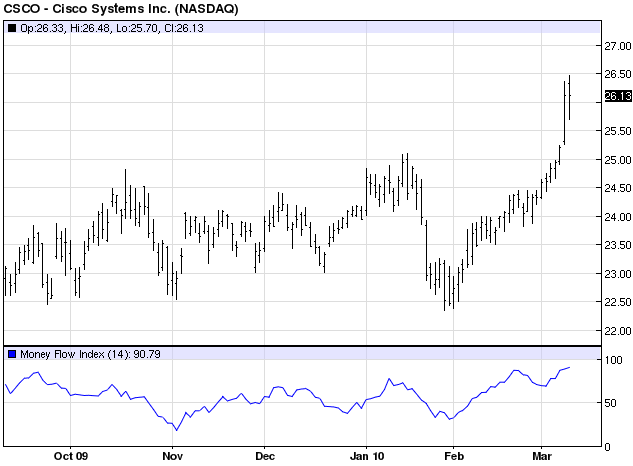Forum on trading, automated trading systems and testing trading strategies
Indicators: Money Flow Index (MFI)
newdigital, 2014.02.24 12:50
Money Flow Index (adapted from barchart article)
The Money Flow Index (MFI) is a momentum indicator that is similar to the Relative Strength Index (RSI) in both interpretation and calculation. However, MFI is a more rigid indicator in that it is volume-weighted, and is therefore a good measure of the strength of money flowing in and out of a security. It compares "positive money flow" to "negative money flow" to create an indicator that can be compared to price in order to identify the strength or weakness of a trend. Like the RSI, the MFI is measured on a 0 - 100 scale and is often calculated using a 14 day period.
The MFI can be interpreted much like the RSI in that it can signal divergences and overbought/oversold conditions.
Positive and negative divergences between the stock and the MFI can be used as buy and sell signals respectively, for they often indicate the imminent reversal of a trend. If the stock price is falling, but positive money flow tends to be greater than negative money flow, then there is more volume associated with daily price rises than with the price drops. This suggests a weak downtrend that threatens to reverse as money flowing into the security is "stronger" than money flowing out of it.
As
with the RSI, the MFI can be used to determine if there is too much or
too little volume associated with a security. A stock is considered
"overbought" if the MFI indicator reaches 80 and above (a bearish
reading). On the other end of the spectrum, a bullish reading of 20 and
below suggests a stock is "oversold".

Calculation
The "flow" of money is the product of price and volume and shows the demand for a security and a certain price. The money flow is not the same as the Money Flow Index but rather is a component of calculating it. So when calculating the money flow, we first need to find the average price for a period. Since we are often looking at a 14-day period, we will calculate the typical price for a day and use that to create a 14-day average.
Typical Price = ((Day High + Day Low + Day Close) / 3)
Money Flow = (Typical Price) x (Volume)
The MFI compares the ratio of "positive" money flow and "negative" money flow. If typical price today is greater than yesterday, it is considered positive money. For a 14-day average, the sum of all positive money for those 14 days is the positive money flow. The MFI is based on the ratio of positive/negative money flow (Money Ratio).
Money Ratio = (Positive Money Flow / Negative Money Flow)
Finally, the MFI can be calculated using this ratio:
Money Flow Index = 100 - [ 100 / (1 + Money Ratio) ]
The fewer number of days used to calculate the MFI, the more volatile it will be.
Parameters
- Period (14) - the number of bars, or interval.
- Free trading apps
- Over 8,000 signals for copying
- Economic news for exploring financial markets
You agree to website policy and terms of use
MFIWithFlat:
Money Flow Index with the market flat state detection option. If the market is flat, the colored indicator cloud shrinks and is located at the value of 50, and a thick gray line appears.
Author: Nikolay Kositsin